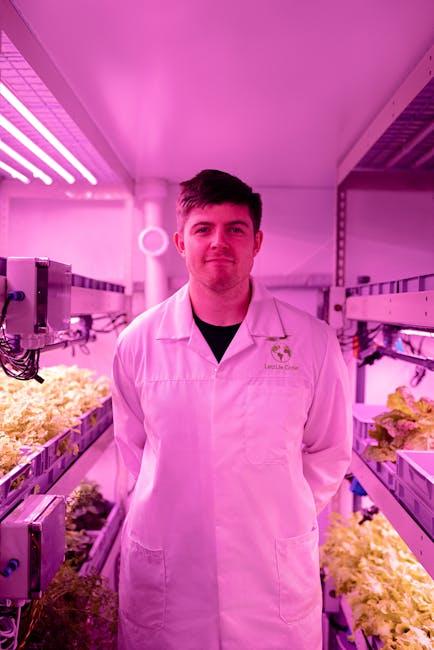In the vast tapestry of life, the thread of genetic code weaves the story of existence, shaping every creature, every cell, every heartbeat. Today, humanity stands at an extraordinary crossroads—armed with the tools to rewrite that very code. Genetic engineering, once the stuff of science fiction, has leapt into reality, unlocking doors to unprecedented possibilities. From curing devastating diseases to designing resilient crops, the promise is immense. Yet, alongside this hopeful horizon lurk shadows of ethical dilemmas, unforeseen consequences, and profound questions about the essence of life itself. As we delve into the intricate world of genetic engineering, we unravel not just the science but the delicate balance between innovation’s bright potential and its possible perils.
Table of Contents
- The Science Behind Genetic Engineering and Its Revolutionary Potential
- Navigating Ethical Boundaries in Genetic Modification
- Assessing Environmental and Health Impacts of Gene Editing
- Strategic Guidelines for Responsible Innovation in Genetic Engineering
- Future Outlook

The Science Behind Genetic Engineering and Its Revolutionary Potential
At its core, genetic engineering involves the deliberate modification of an organism’s DNA to achieve desired traits that traditional breeding cannot easily access. Using advanced tools like CRISPR-Cas9, scientists can target specific genes with unparalleled precision, enabling the insertion, deletion, or alteration of genetic sequences. This molecular scissor technology has revolutionized biotechnology by making gene editing not only more efficient but also more accessible, sparking a cascade of innovations across medicine, agriculture, and environmental science.
The possibilities unlocked by genetic engineering stretch far beyond mere modification. Consider these transformative applications:
- Medicine: Custom therapies for genetic disorders and cancer, including gene therapy that can correct mutations at the source.
- Agriculture: Crops engineered for drought resistance, improved nutrition, and reduced reliance on pesticides.
- Environment: Engineered microbes designed to degrade pollutants, offering new approaches to ecological restoration.
| Technology | Impact | Example |
|---|---|---|
| CRISPR-Cas9 | Precise genome editing | Sickle cell disease gene correction |
| Gene Drives | Control of populations | Malaria mosquito population suppression |
| Recombinant DNA | Protein production | Insulin manufacturing |

Navigating Ethical Boundaries in Genetic Modification
The fast-evolving field of genetic modification opens a Pandora’s box of ethical dilemmas that society must confront head-on. At its core, it challenges our fundamental views about what it means to be human and the responsibility we hold toward future generations. The ability to edit genes, whether to eradicate hereditary diseases or enhance human traits, is a double-edged sword. It invites us to weigh the potential benefits against the risks of unintended consequences, including ecological imbalance, social inequality, and the erosion of natural diversity. As we tread this fine line, transparency, rigorous regulatory frameworks, and public dialogue become essential pillars in guiding responsible innovation.
Ethical considerations extend beyond the laboratory into broader societal impacts, urging stakeholders to ask critical questions such as:
- Who decides which traits are desirable or undesirable?
- How do we ensure equitable access to genetic technologies?
- What protections must be in place to prevent genetic discrimination?
- Can we fully anticipate the long-term effects on human genetics and biodiversity?
Balancing scientific progress with moral accountability requires a multidisciplinary approach, blending insights from bioethics, law, sociology, and environmental science. Navigating these boundaries responsibly is not just a scientific challenge; it is a social imperative that demands inclusive conversations and ethical foresight at every step.
| Ethical Consideration | Key Questions | Potential Risks |
|---|---|---|
| Consent | Can future generations consent to genetic changes? | Violation of autonomy, unforeseen gene effects |
| Equity | Who benefits from gene editing? | Increased social inequality |
| Biodiversity | Does modification threaten natural gene pools? | Loss of species diversity |
| Regulation | How strict should oversight be? | Ethical lapses, unsafe applications |

Assessing Environmental and Health Impacts of Gene Editing
Advancements in gene editing have opened unprecedented opportunities for scientific progress, yet the intricate balance between innovation and caution is imperative. Gene-editing technologies, such as CRISPR-Cas9, pose complex questions about their long-term effects on ecosystems and human health. Potential environmental impacts include unintended genetic drift, where modified genes escape into wild populations, possibly disrupting biodiversity and natural selection processes. The ripple effect of such alterations could transform habitats and food chains in unpredictable ways, raising concerns about maintaining ecological equilibrium.
In assessing human health implications, it is critical to weigh the therapeutic benefits against potential risks such as off-target mutations and immune responses. The following list highlights key factors in evaluating these impacts:
- Gene Stability: Monitoring the persistence and behavior of edited genes across generations.
- Allergenicity: Ensuring no new allergens are introduced in genetically enhanced organisms.
- Resistance Development: Preventing the rise of resistant pathogens or pests as unintended consequences.
- Ethical Oversight: Incorporating public engagement and regulatory frameworks to guide safe use.
| Impact Area | Potential Concern | Mitigation Strategy |
|---|---|---|
| Environmental | Gene flow to wild species | Containment measures; ecological monitoring |
| Health | Off-target effects | Advanced targeting techniques; rigorous testing |
| Ethical | Equitable access | Inclusive policy development |

Strategic Guidelines for Responsible Innovation in Genetic Engineering
Navigating the complex landscape of genetic innovation requires a balanced framework centered on transparency, ethical foresight, and societal benefit. Stakeholders should prioritize multi-disciplinary collaboration, inviting insights from ethicists, scientists, policymakers, and affected communities to sculpt well-rounded approaches. Embedding continuous risk assessments and dynamic regulation mechanisms safeguards against unforeseen consequences, ensuring that technological leaps serve humanity without compromising ecological or moral boundaries.
Key components to achieve sustainable innovation include:
- Inclusive dialogue: Engaging diverse perspectives to democratize decision-making
- Adaptive policy frameworks: Preparing laws that evolve alongside scientific advancements
- Educational initiatives: Raising awareness and literacy on genetic engineering potentials and risks
- Ethical impact audits: Regular reviews of research trajectories to align with societal values
| Guideline | Purpose | Outcome |
|---|---|---|
| Transparency in Research | Foster public trust and open knowledge sharing | Increased societal engagement |
| Precautionary Measures | Prevent ecological and ethical harm | Balanced innovation progress |
| Stakeholder Inclusion | Incorporate diverse viewpoints and concerns | Equitable innovation benefits |
| Regulatory Agility | Adapt rules with technological changes | Reduced regulatory lag |
Future Outlook
As the double helix continues to unfold its secrets, genetic engineering stands at the crossroads of remarkable potential and profound responsibility. It beckons us with the promise of curing diseases, enhancing agriculture, and reshaping life itself—while simultaneously challenging our ethical compass and societal boundaries. In this delicate dance between innovation and caution, the true measure of progress will lie not just in what we can engineer, but in how thoughtfully we choose to wield this unprecedented power. The story of genetic engineering is far from written; it is a living narrative that invites us all to participate, question, and shape the future of life on Earth.



